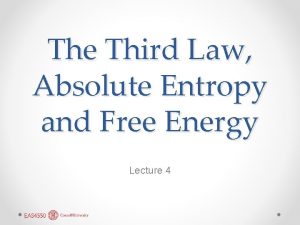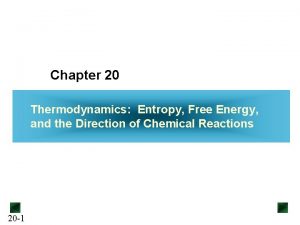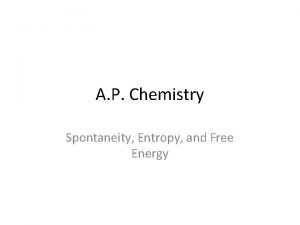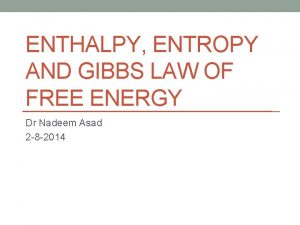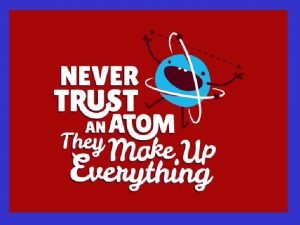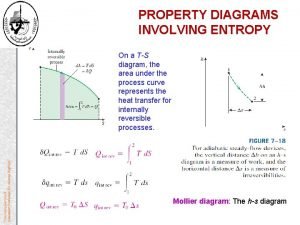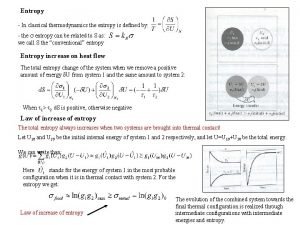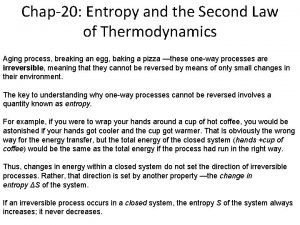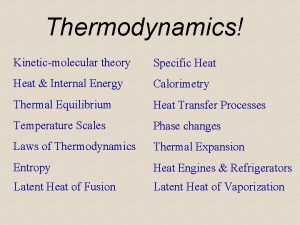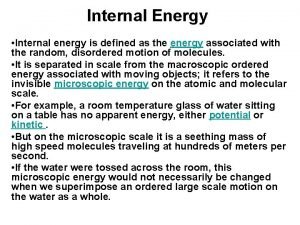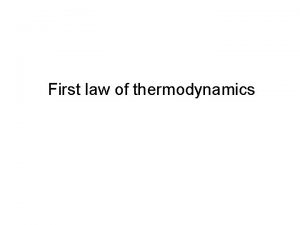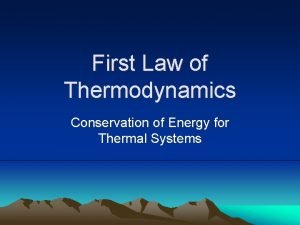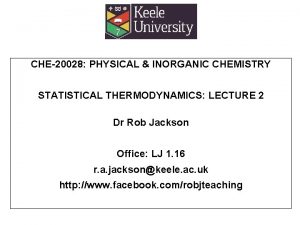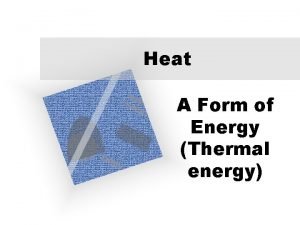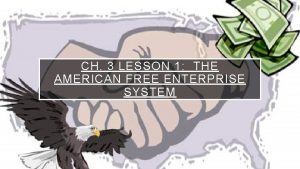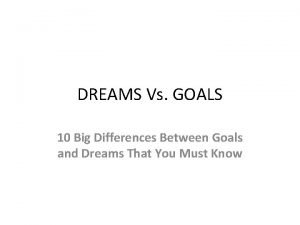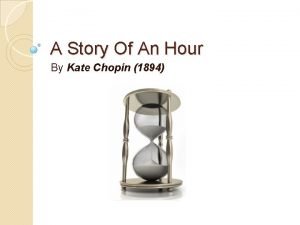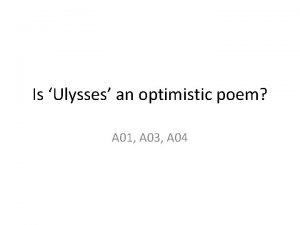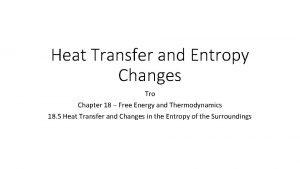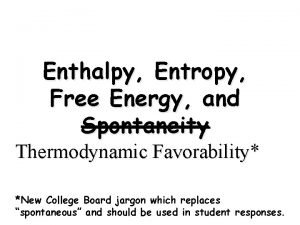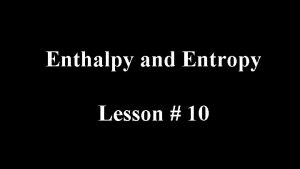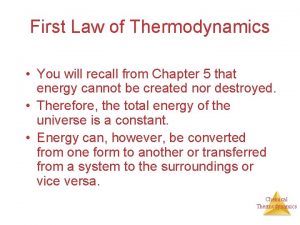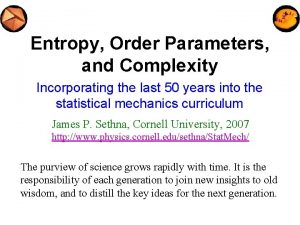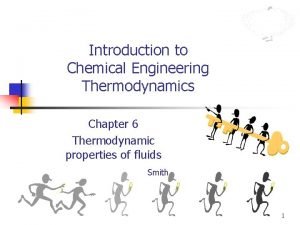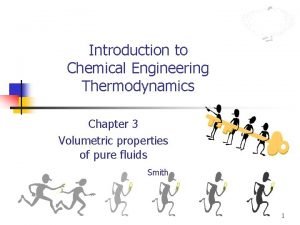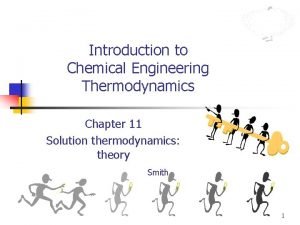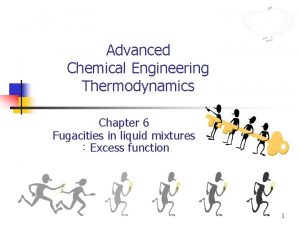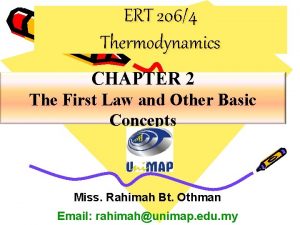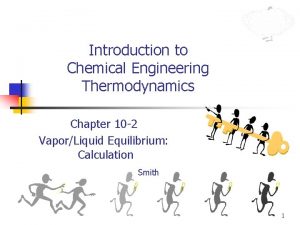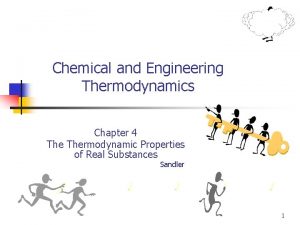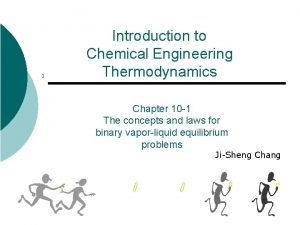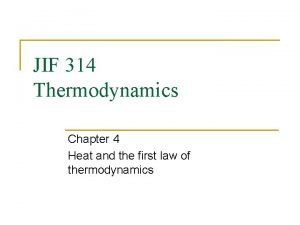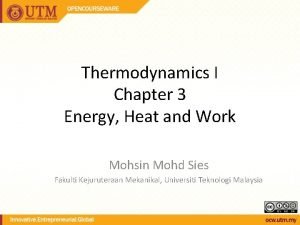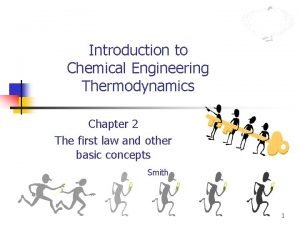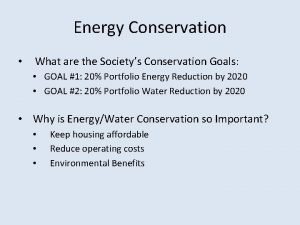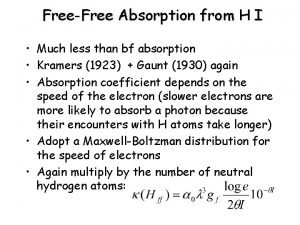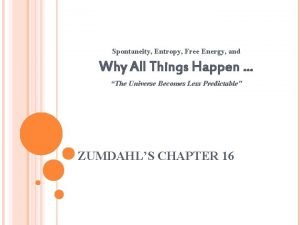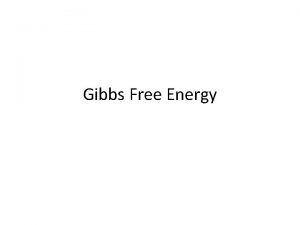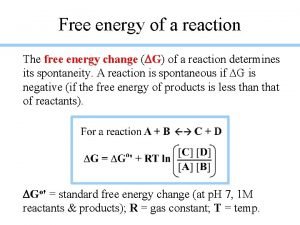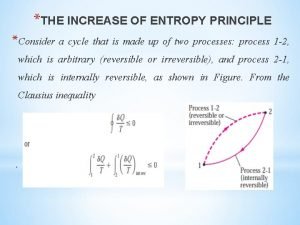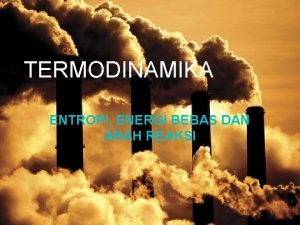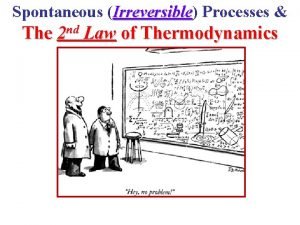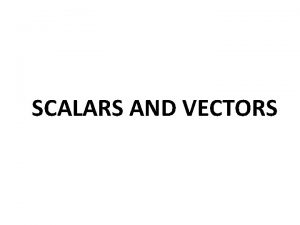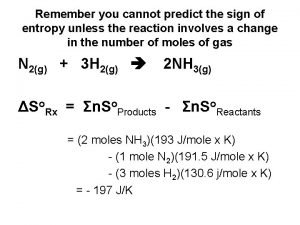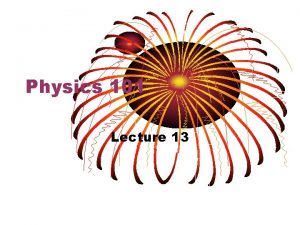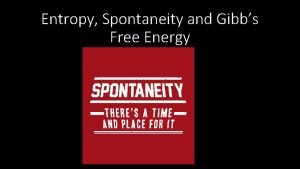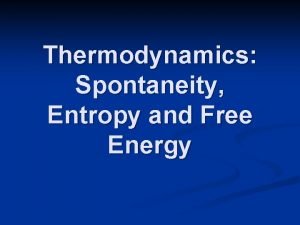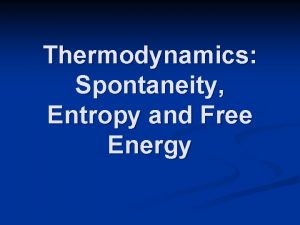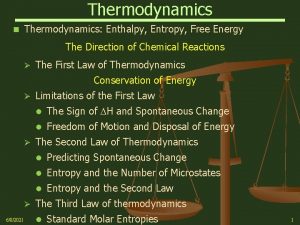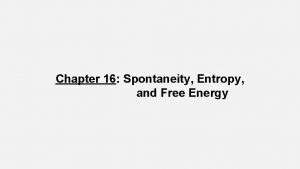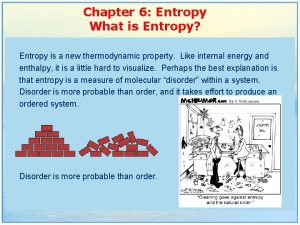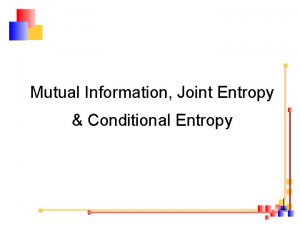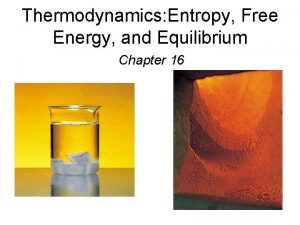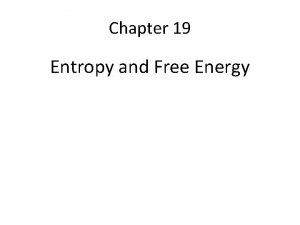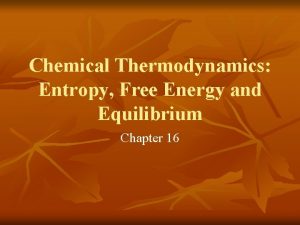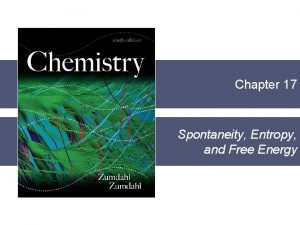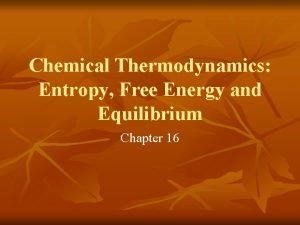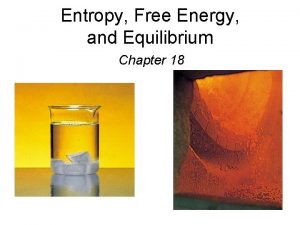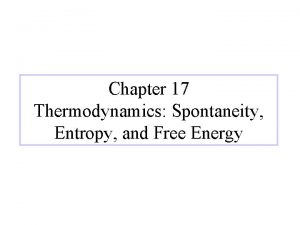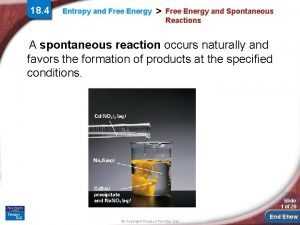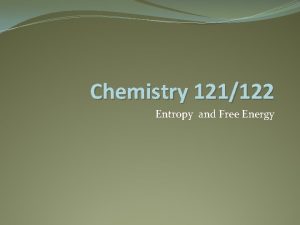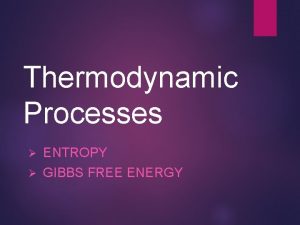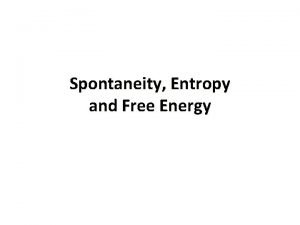Chapter 17 Free Energy and Thermodynamics Goals Entropy


























































- Slides: 58

Chapter 17 Free Energy and Thermodynamics

Goals Entropy (S, S) and spontaneity Free energy; G, Go G, K, product- or reactant-favored Review: H (Enthalpy) and the 1 st Law of Thermodynamics Chemical Equilibria (ch. 14, etc)

First Law of Thermodynamics • First Law of Thermodynamics: Energy cannot be created or destroyed üthe total energy of the universe cannot change üit can be transfered from one place to another · Euniverse = 0 = Esystem + Esurroundings system = reactants & products surroundings = everything else (the transfer of energy from one to the other does not change the energy of the universe) 3

First Law of Thermodynamics For an exothermic reaction, heat from the system goes into the surroundings • two ways energy can be “lost” from a system, üconverted to heat, q üused to do work, w Energy conservation requires that the energy change in the system = heat exchanged + work done on the system. ü E = q + w ( E = internal energy change) ü E = H – P V (at const. P, qp = H, enthalpy change) • State functions (H, P, V). q and w are not. üinternal energy change ( E) independent of how done 4

Enthalpy, H • • • related to (includes) the internal energy H generally k. J/mol stronger bonds = more stable molecules if products more stable than reactants, energy released; exothermic ü H = negative if reactants more stable than products, energy absorbed; endothermic ü H = positive The enthalpy is favorable for exothermic reactions and unfavorable for endothermic reactions. • Hess’ Law: H°rxn = ( Hf°prod) - ( Hf°react) 5

Thermodynamics and Spontaneity • thermodynamics predicts whether a process will proceed (occur) under the given conditions üspontaneous process Ønonspontaneous process does not occur under specific conditions. • spontaneity is determined by comparing the free energy (G) of the system before the reaction with the free energy of the system after reaction. üif the system after reaction has less free energy than before the reaction, the reaction is thermodynamically favorable. • spontaneity ≠ fast or slow (rate); this is kinetics 6

Spontaneous ice melts @ 25 o. C water freezes @ -10 o. C Nonspontaneous water freezes @ 25 o. C ice melts @ -10 o. C ball rolls downhill ball rolls uphill 2 Na(s) + 2 H 2 O(l) H 2(g) + 2 Na. OH(aq) 2 Na(s) + 2 H 2 O(l) 7

Diamond → Graphite kinetics: how fast Spontaneity: direction & extent kinetics Graphite is thermodynamically more stable than diamond, so the conversion of diamond into graphite is spontaneous – but it’s kinetically too slow (inert) it will never happen in many, many generations. 8

Factors Affecting Whether a Reaction Is Spontaneous • The two factors that determine thermodynamic • • • favorability are the enthalpy and the entropy. The enthalpy is a comparison of the bond energy of the reactants to the products. übond energy = amount needed to break a bond. ü H The entropy factors relate to the randomness/orderliness of a system ü S The enthalpy factor is generally more important than the entropy factor 9


Entropy, S Entropy is usually described as a measure of the randomness or disorder; the greater the disorder of a system, the greater its S. The greater the order the smaller its S. • Entropy is a thermodynamic function that increases as the number of energetically equivalent ways of arranging the components increases. · S generally in J/K (joules/K) • S = k ln. W ük = Boltzmann Constant (R/NA) = 1. 38 10 -23 J/K üW is the number of energetically equivalent ways, 11 (microstates). It is unitless.

Entropy & Microstates, W Energetically Equivalent States for the Expansion of a Gas (4 gas molecules) 1 microstate S = k ln Wf - k ln Wi S = k ln W 1 microstate if Wf > Wi , S > 0 & entropy increases. 6 microstates (most probable distribution) 12

Changes in Entropy, S • entropy change is favorable when the result is a more random system (State C: higher entropy). ü S is positive ( S > 0) Some changes that increase the entropy are: rxns where products are in a more disordered state. (solid > liquid > gas) less order (solid< liquid < gas) larger S (disorder) reactions which have larger numbers of product molecules than reactant molecules. increase in temperature (more movement) solids dissociating into ions upon dissolving 13

Changes in Entropy in a System (melting) Particles fixed in space Particles can occupy many positions 14

Changes in Entropy in a System (vaporization) Particles occupy more space (larger volume) 15

Changes in Entropy in a System (solution process) Structure of solute and solvent disrupted (also more solute particles) 16

Predict entropy change for a process/reaction For which process/reaction is S negative? Freezing ethanol entropy dec Mixing CCl 4 with C 6 H 6 Condensing bromine vapor entropy dec 2 O 3(g) 3 O 2(g) 4 Fe(s) + 3 O 2(g) 2 Fe 2 O 3(s) entropy dec 2 H 2 O 2(aq) 2 H 2 O(l) + O 2(g) 2 Li(s) + 2 H 2 O(l) 2 Li. OH(aq) + H 2(g) 2 NH 3(g) N 2(g) + 3 H 2(g) 17

The 2 nd Law of Thermodynamics • The entropy of the universe increases in a spontaneous process. ü Suniverse = Ssystem + Ssurroundings > 0 ü Suniverse = Ssystem + Ssurroundings = 0 (equilibrium) If Ssystem >> 0, Ssurroundings < 0 for Suniverse > 0! üIf Ssystem < 0, Ssurroundings >> 0 for Suniverse > 0! • the increase in Ssurroundings often comes from the heat released in an exothermic reaction, Hsystem < 0. 18

The 3 rd Law of Thermodynamics -allows determination of entropy of substances. (W = 1, there is only one way to arrange the particles to form a perfect crystal) S = k ln W = k ln 1 = 0 the 3 rd Law states that for a perfect crystal at absolute zero, the absolute entropy = 0 J/mol∙K S = Sf – Si; where Si = 0 @ 0 K the absolute entropy of a substance is always (+) positive at the new T S = k ln W 19

Standard Entropies • S° • entropies for 1 mole at 298 K for a particular state, a particular allotrope, particular molecular complexity, a particular molar mass, and a particular degree of dissolution Values can be used to calculate the standard entropy change for a reaction, Sorxn (= Sosys 20 )


Trends: Standard Entropies Molar Mass • For monatomic species, the • larger the molar mass, the larger the entropy available energy states more closely spaced, allowing more dispersal of energy through the states 22

Trends: Standard Entropies States • the standard entropy of a substance in the gas phase is greater than the standard entropy of the same substance in the solid or liquid phase at a particular temperature Substance S°, (J/mol∙K) H 2 O (l) 70. 0 H 2 O (g) 188. 8 23

Trends: Standard Entropies Allotropes -different forms of an element • the more highly ordered form has the smaller entropy 24

Trends: Standard Entropies Molecular Complexity (inc # of atoms) Molar S°, Substance Mass (J/mol∙K) Ar (g) 39. 948 154. 8 larger, more complex molecules generally have NO (g) larger entropy • more available energy states, allowing more dispersal of energy through the states 30. 006 210. 8 25

Trends: Standard Entropies Dissolution • dissolved solids generally • have larger entropy distributing particles throughout the mixture Substance S°, (J/mol∙K) KCl. O 3(s) 143. 1 KCl. O 3(aq) 265. 7 26

Q. Arrange the following in order of increasing entropy @ 25 o. C! (lowest to highest) Ne(g), SO 2(g), Na(s), Na. Cl(s) and H 2(g) Na(s) < Na. Cl(s) < H 2(g) < Ne(g) < SO 2(g) Q. Which has the larger entropy in each pair? a) Li(s) or Li(l) b) C 2 H 5 OH(l) or CH 3 OCH 3 (l) c) Ar(g) or Xe(g) d) O 2(g) or O 3(g) 27

Substance S , J/mol K NH 3(g) 192. 8 O 2(g) 205. 2 NO(g) 210. 8 H 2 O(g) standard entropies from Appendix IIB 188. 8 Calculate S for the reaction 4 NH 3(g) + 5 O 2(g) 4 NO(g) + 6 H 2 O(g) Given: Find: S, J/K Concept Plan: S NH 3, S O 2, S NO, S H 2 O, S Relationships: Solution: Check: S is +, as you would expect for a reaction with more gas product molecules than reactant molecules

Calculating ∆So for a Reaction ∆So = So (products) - So (reactants) Consider 2 H 2(g) + O 2(g) 2 H 2 O(liq) @ 25 o. C ∆So = 2 So (H 2 O) - [2 So (H 2) + So (O 2)] ∆So = 2 mol (69. 9 J/K • mol) [2 mol (130. 6 J/K • mol) + 1 mol (205. 0 J/K • mol)] ∆So = -326. 4 J/K Note that there is a decrease in S because 3 mol of gas give 2 mol of liquid.

Temperature Dependence of Ssurroundings Hsystem < 0 (exothermic), it adds heat to the surroundings, increasing the entropy of the surroundings ( Ssurroundings > 0 ) Hsystem > 0 (endothermic), it takes heat from the surroundings, decreasing the entropy of the surroundings ( Ssurroundings < 0 ) The more negative Hsyst and the lower the temperature the higher (more positive) Ssurr 30

Calculating ∆So for the surroundings 2 H 2(g) + O 2(g) 2 H 2 O(liq) @ 25 o. C ∆Sosystem = -326. 4 J/K Can calculate ∆Hosystem = ∆Horxn = -571. 7 k. J (also from tabulated data) ∆Sosurroundings = +1917 J/K

Suniverse = Ssystem + Ssurroundings Given Sosurr , Sosys and T, determine Souniv and predict if the reaction will be spontaneous. 2 H 2(g) + O 2(g) 2 H 2 O(liq) @ 25 o. C ∆Sosystem = -326. 4 J/K ∆Sosurroundings = +1917 J/K ∆Souniverse = +1591 J/K The entropy of the universe is increasing, so the reaction is spontaneous ( productfavored). (see slide # 18)

The reaction C 3 H 8(g) + 5 O 2(g) 3 CO 2(g) + 4 H 2 O(g) has Hrxn = -2044 k. J at 25°C. Calculate the entropy change of the surroundings. Given: Find: Concept Plan: Hsystem = -2044 k. J, T = 298 K Ssurroundings, J/K T, H S Relationships: Solution: Check: combustion is largely exothermic, so the entropy of the surroundings should increase (inc in # gas mol)

Spontaneous or Not? Suniverse = Ssystem – Hsystem/T Hsystem Ssystem Spontaneous? Exothermic Hsys < 0 Less order Ssys > 0 Spontaneous under all conditions; Suniv > 0 Exothermic Hsys < 0 More order Ssys < 0 Favorable at low T Endothermic Hsys > 0 Less order Ssys > 0 Favorable at high T Endothermic Hsys > 0 More order Ssys < 0 Not spontaneous under any conditions Suniv < 0 originally: Suniverse = Ssystem + Ssurroundings but

Without doing any calculations, determine the sign of Ssys and Ssurr for each reaction. Predict under what temperatures (all T, low T, or high T) the reaction will be spontaneous. Suniverse = Ssystem + (- Hsys/T) Ssurr = (- Hsys/T) 2 CO(g) + O 2(g) 2 CO 2(g) Hrxn = -566. 0 k. J Ssystem = (-); 3 mol gas form 2 mol gas Ssurr = (+); spontaneous @ low T 2 NO 2(g) + 2 NO(g) Hrxn = +113. 1 k. J Ssystem = (+); 2 mol gas form 3 mol gas Ssurr = (-); spontaneous @ high T 35

Without doing any calculations, determine the sign of Ssys and Ssurr for each reaction. Predict under what temperatures (all T, low T, or high T) the reaction will be spontaneous. Suniverse = Ssystem + (- Hsys/T) 2 H 2(g) + O 2(g) 2 H 2 O(g) Hrxn = -483. 6 k. J Ssystem = (-); 3 mol gas form 2 mol gas Ssurr = (+) ; spontaneous @ low T CO 2(g) C(s) + O 2(g) Hrxn = +393. 5 k. J Ssystem = (-); complicated gas forms a solid & gas Ssurr = (-); nonspontaneous @ all T Ssurr = (- Hsys/T) 36

At what temperature is the change in entropy for the reaction equal to the change in entropy for the surroundings, if Horxn = -127 k. J and Sorxn = 314 J/K. Plan: set Sorxn = Sosurr and solve for T; convert k. J to J rxn implies system!!! Ans: T = +404 K 37

Gibbs Free Energy, G = H -TS ∆Suniv = ∆Ssurr + ∆Ssys Multiply through by -T -T∆Suniv = ∆Hsys - T∆Ssys J. Willard Gibbs 1839 -1903 -T∆Suniv = change in Gibbs free energy for the system = ∆Gsystem hence, ∆G = ∆H -T∆S Under standard conditions — ∆Gosys = ∆Hosys - T∆Sosys

∆G = ∆H - T∆S Gibbs free energy change = total energy change for system - energy lost in disordering the system If the reaction is • exothermic (negative ∆H) • and entropy increases (positive ∆So) • then ∆G must be NEGATIVE • the reaction is spontaneous (and productfavored) at ALL temperatures.

∆G = ∆H - T∆S • G will be positive (∆G > 0) when H is positive (endothermic) and S is negative (more ordered). So the change in free energy will be positive at all temperatures. • The reaction will therefore be nonspontaneous at ALL temperatures • When G = 0 the reaction is at equilibrium 40

G = H – T S Spontaneous or Not? A decrease in Gibbs free energy ( G < 0) corresponds to a spontaneous process An increase in Gibbs free energy ( G > 0) corresponds to a nonspontaneous process 41

Calculating ∆Go : ∆Go = ∆H -T∆So Combustion of acetylene @ 25 o. C C 2 H 2(g) + 5/2 O 2(g) 2 CO 2(g) + H 2 O(g) Use enthalpies of formation to calculate ∆Horxn = -1238 k. J Use standard molar entropies to calculate ∆Sorxn = -97. 4 J/K or -0. 0974 k. J/K ∆Gorxn = -1238 k. J - (298 K)(-0. 0974 J/K) = -1209 k. J (spontaneous) Reaction is product-favored in spite of negative ∆Sorxn. Reaction is “enthalpy driven”

Calculating ∆Go : ∆Go = ∆H -T∆So Is the dissolution of ammonium nitrate productfavored? If so, is it enthalpy- or entropy-driven? NH 4 NO 3(s) + heat NH 4 NO 3(aq) From tables of thermodynamic data we find ∆Horxn = +25. 7 k. J (endothermic) ∆Sorxn = +108. 7 J/K or +0. 1087 k. J/K (disorder) ∆Gorxn = +25. 7 k. J - (298 K)(+0. 1087 k. J/K) = -6. 7 k. J (spontaneous) Reaction is product-favored in spite of positive ∆Horxn. Reaction is “entropy driven”

The reaction CCl 4(g) C(s, graphite) + 2 Cl 2(g) has H = +95. 7 k. J and S = +142. 2 J/K at 25°C. Calculate G and determine if it is spontaneous. Given: Find: Concept Plan: H = +95. 7 k. J, S = 142. 2 J/K, T = 298 K G, k. J T, H, S G Relationships: Solution: Answer: Since G is +, the reaction is not spontaneous at this temperature. To make it spontaneous, we need to increase the temperature.

The reaction CCl 4(g) C(s, graphite) + 2 Cl 2(g) has H = +95. 7 k. J and S = +142. 2 J/K. Calculate the minimum T @ which it will be spontaneous. Given: Find: Concept Plan: H = +95. 7 k. J, S = 142. 2 J/K, G < 0 T, K G, H, S T Relationships: Solution: Answer: The temperature must be higher than 673 K for the reaction to be spontaneous (i. e. 674 K)

Gibbs Free Energy, G Calculating ∆Go (two ways) a) Determine ∆Horxn and ∆Sorxn and use Gibbs equation (at various temps). b) free energies of formation, ∆Gfo Use tabulated values of @ 25 o. C ∆Gorxn = ∆Gfo (products) - ∆Gfo (reactants)

47

Calculate G at 25 C for the reaction CH 4(g) + 8 O 2(g) CO 2(g) + 2 H 2 O(g) + 4 O 3(g) G f, k. J/mol -50. 5 0. 0 -394. 4 -228. 6 163. 2 Substance CH 4(g) O 2(g) CO 2(g) H 2 O(g) O 3(g) Given: standard free energies of formation from Appendix IIB Find: G , k. J Concept Plan: G f of prod & react G Relationships: Solution: (spontaneous)

The reaction SO 2(g) + ½ O 2(g) SO 3(g) has H = -98. 9 k. J and S = -94. 0 J/K at 25°C. Calculate G at 125 C and determine if it is spontaneous. Given: Find: Concept Plan: H = -98. 9 k. J, S = -94. 0 J/K, T = 398 K G , k. J (PRACTICE PROBLEM) T, H , S G Relationships: Solution: Answer: Since G is -ve, the rxn is spontaneous at this temperature, but less spontaneous than at 25 C (-127 k. J)

∆G, ∆G˚, and Keq • ∆G is the change in free energy at non • • • standard conditions. ∆G is related to ∆G˚ ∆G = ∆G˚ + RT ln Q where Q = reaction quotient When Q < K or Q > K, the reaction may be spontaneous or nonspontaneous. When Q = K reaction is at equilibrium When ∆G = 0 reaction is at equilibrium • Therefore, ∆G˚ = - RT ln K

Thermodynamics and Keq u FACT: ∆Gorxn is the change in free energy when pure reactants convert COMPLETELY to pure products, both at standard conditions. u FACT: Product-favored systems have Keq > 1 (∆G˚rxn < 0). 0) u Therefore, both ∆G˚rxn and Keq are related to reaction favorability. Summary: ∆G˚ = - RT ln K

Thermodynamics and Keq ∆Gorxn = - RT ln. K Calculate K for the reaction @ 25 o. C N 2 O 4 2 NO 2 ∆Gorxn = +4. 8 k. J ∆Gorxn = +4800 J = - (8. 31 J/K)(298 K) ln K K = e– 1. 94 = 0. 14 (reactant favored) When ∆Gorxn > 0 (nonspontaneous), then K < 1!!

• Estimate the equilibrium constant and position of equilibrium for the following reaction at 427°C N 2(g) + 3 H 2(g) ⇄ 2 NH 3(g) NH 3 N 2 H° = [ 2(-46. 19)] − [ 0 H 2 +3( 0)] = -92. 38 k. J = -92380 J S° = [2 (192. 5)] − [(191. 50) + 3(130. 58)] = -198. 2 J/K G° = -92380 J - (700 K)(-198. 2 J/K) G° = +46400 J (nonspontaneous) G° = -RT ln. K +46400 J = -(8. 314 J/K)(700 K) ln. K ln K = -7. 97 K = e− 7. 97 = 3. 45 10− 4 small!!! since K is << 1, the position of equilibrium favors reactants

• Calculate G at 427°C for the reaction below if the PN 2 = 33. 0 atm, PH 2= 99. 0 atm, and PNH 3= 2. 0 atm N 2(g) + 3 H 2(g) ⇄ 2 NH 3(g) Q= PNH 32 PN 21 PH 23 = (2. 0 atm)2 (33. 0 atm)1 (99. 0)3 = 1. 2 10 -7 H° = [ 2(-46. 19)] - [0 +3( 0)] = -92. 38 k. J = -92380 J S° = [2 (192. 5)] - [(191. 50) + 3(130. 58)] = -198. 2 J/K G° = -92380 J - (700 K)(-198. 2 J/K) G° = +46400 J (nonspontaneous) G = G° + RTln. Q spontaneous G = +46400 J + (8. 314 J/K)(700 K)(ln 1. 2 10 -7) G = 46400 J − 92700 J = -46300 J = − 46 k. J − G° 54

Q. Rank the following in order of increasing molar entropy (So) @ 25 o. C! a) Cl 2(g), I 2(g), Br 2(g), and F 2(g) < Cl 2(g) < Br 2(g) < I 2(g) b) H 2 O(g), H 2 O 2 (g), H 2 S(g) H 2 O(g) < H 2 S(g) < H 2 O 2(g) 55

Use only the information provided here to determine the value of Ssurr @ 355 K. Predict whether this reaction shown will be spontaneous @ this temperature, if Hrxn = -114 k. J. A) Ssurr = +114 k. J/K, reaction is not spontaneous B) Ssurr = +321 J/K, reaction is spontaneous C) Ssurr = +114 k. J/K, reaction is spontaneous D) Ssurr = -355 J/K, reaction is not spontaneous E) Ssurr = +321 J/K, it is not possible to predict the spontaneity of this reaction without more information. 56

G under Nonstandard Conditions G = G only when the reactants and products are in their standard states there normal state at that temperature partial pressure of gas = 1 atm concentration = 1 M under nonstandard conditions, G = G + RTln. Q Q is the reaction quotient at equilibrium G = 0 G = − RTln. K and G° = H − T S° = − RTln. K, by rearranging RTln. K = − H − T S°, and dividing by R T

Temperature Dependence of K RTln. K − H T S° ———— = ———— + ———— RT RT RT • for an exothermic reaction, increasing the temperature • decreases the value of the equilibrium constant for an endothermic reaction, increasing the temperature increases the value of the equilibrium constant
 Relationship between entropy and free energy
Relationship between entropy and free energy Entropy and gibbs free energy
Entropy and gibbs free energy Ap chemistry entropy and free energy
Ap chemistry entropy and free energy Strategic goals tactical goals operational goals
Strategic goals tactical goals operational goals Strategic goals tactical goals operational goals
Strategic goals tactical goals operational goals Helmholtz free energy and gibbs free energy
Helmholtz free energy and gibbs free energy Negative delta g
Negative delta g Enthalpy entropy free energy
Enthalpy entropy free energy Thermodynamics
Thermodynamics Entropy in thermodynamics
Entropy in thermodynamics Thermodynamic second law
Thermodynamic second law Gibbs free energy non standard conditions
Gibbs free energy non standard conditions Unit of entropy
Unit of entropy Gibbs free energy vs standard free energy
Gibbs free energy vs standard free energy General goals and specific goals
General goals and specific goals Examples of generic goals and product-specific goals
Examples of generic goals and product-specific goals Energy energy transfer and general energy analysis
Energy energy transfer and general energy analysis Energy energy transfer and general energy analysis
Energy energy transfer and general energy analysis Entropy equation
Entropy equation First law of thermodynamics open system
First law of thermodynamics open system Si unit of energy
Si unit of energy Quasi static process
Quasi static process First law of td
First law of td Internal energy formula thermodynamics
Internal energy formula thermodynamics Thermal energy calculation formula
Thermal energy calculation formula Free enterprise system characteristics
Free enterprise system characteristics Difference between dreams and goals
Difference between dreams and goals Free body and soul free
Free body and soul free Free hearts free foreheads you and i are
Free hearts free foreheads you and i are Q system = -q surroundings
Q system = -q surroundings What is enthalpy and entropy
What is enthalpy and entropy Minimum enthalpy and maximum entropy
Minimum enthalpy and maximum entropy Entropy of system and surroundings
Entropy of system and surroundings Entropy order parameters and complexity
Entropy order parameters and complexity Chapter 6
Chapter 6 Chemical engineering thermodynamics 8th solution chapter 3
Chemical engineering thermodynamics 8th solution chapter 3 Chemical engineering thermodynamics 8th solution chapter 4
Chemical engineering thermodynamics 8th solution chapter 4 Chapter 6
Chapter 6 Control mass system
Control mass system Chemical engineering thermodynamics 8th solution chapter 10
Chemical engineering thermodynamics 8th solution chapter 10 Thermodynamics chapter 4
Thermodynamics chapter 4 Thermodynamics for chemical engineering
Thermodynamics for chemical engineering Thermodynamics chapter 4
Thermodynamics chapter 4 Thermodynamics chapter 3
Thermodynamics chapter 3 Thermodynamics chapter 2
Thermodynamics chapter 2 Energy conservation goals
Energy conservation goals Chapter 7 energy conservation of energy
Chapter 7 energy conservation of energy A free map determines which blocks are free, allocated.
A free map determines which blocks are free, allocated. Free free absorption
Free free absorption Gibbs free energy and spontaneity
Gibbs free energy and spontaneity Gibbs free energy practice problems with answers
Gibbs free energy practice problems with answers Nad+
Nad+ Increase in entropy principle
Increase in entropy principle Reverse entropy
Reverse entropy Reversible process
Reversible process Work done in isentropic process
Work done in isentropic process Entropy is scalar or vector
Entropy is scalar or vector Predict the sign of the entropy change
Predict the sign of the entropy change Thermodynamic temperature
Thermodynamic temperature
